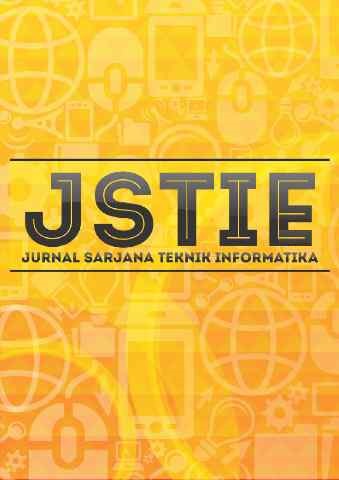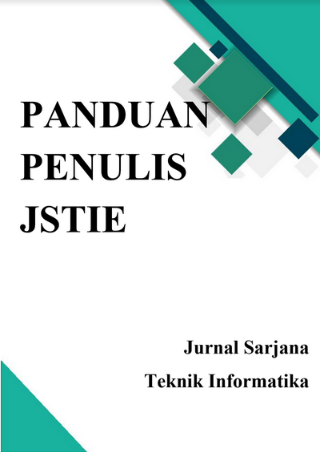Pengembangan Fitur Achievement Pada Game Virtual Academic
DOI:
https://doi.org/10.12928/jstie.v10i1.21561Keywords:
Game, Virtual Academic, Achievement, Role Play Game, Research and DevelopmentAbstract
Salah satu komponen penting dalam sebuah permainan adalah achievement dan reward karena dapat meningkatkan aktivitas pengguna terhadap game tersebut. Selaras dengan tujuan dibuatnya Game Virtual Academic yaitu meningkatkan aktivitas mahasiswa terhadap portal akademik dengan format berbeda yaitu berbentuk permainan. Berdasarkan hasil kuesioner informasi yang paling dicari yaitu Presensi sebanyak 50%, Kartu Rencana Studi 25%, Kartu Hasil Studi 13%, Transkrip Nilai 8%, dan Pembayaran 2%. Berdasarkan data tersebut sekitar 13% mahasiswa yang melakukan pencarian informasi terhadap hasil studinya menunjukkan bahwa minat mereka dalam melakukan pemantauan hasil capaiannya kurang jika dibandingkan dengan pencarian informasi presensi dan Kartu Rencana Studi.Metode yang digunakan dalam penelitian ini adalah metode Research and Development, dengan tahapan Desain Produk, Prototyping, Uji Coba Pemakaian dan Testing untuk menghasilkan sebuah prototype arsitektur fitur achievement Game Virtual Academic menggunakan software Adobe XD sebagai media desain user interface dan prototype.Penelitian ini dilakukan melalui tahapan desain produk yang telah disepakati oleh tim pengembang dan telah diuji dengan melibatkan seluruh anggota tim pengembang. Hasil akhir dari penelitian ini berupa prototype arsitektur fitur achievement yang telah dinyatakan dapat diterima dengan menggunakan pengujian User Acceptance Test dengan persentase hasil User Acceptance Test dengan jawaban sangat setuju sebesar 75% dan jawaban setuju sebesar 25%.References
N. Pellas and S. Mystakidis, “A Systematic Review of Research about Game-based Learning in Virtual Worlds,” JUCS - J. Univers. Comput. Sci., vol. 26, no. 8, pp. 1017–1042, Aug. 2020, doi: 10.3897/jucs.2020.054.
A. M. Chandra, I. A. Suhendra, L. T. Informatika, F. T. Industri, L. S. Komputer, and F. Ilmu, “Pembuatan Model 3D Karakter Manusia pada Game ‘ Crime of Metropolis ,’” Genre.
S. L. Rahayu, Fujiati, and R. Dewi, “Educational Games as A learning media of Character Education by Using Multimedia Development Life Cycle (MDLC),” 2018 6th Int. Conf. Cyber IT Serv. Manag. CITSM 2018, no. Citsm, pp. 1–4, 2019, doi: 10.1109/CITSM.2018.8674288.
“Evaluating a game-development approach to teach introductory programming concepts in secondary education | International Journal of Technology Enhanced Learning.” https://www.inderscienceonline.com/doi/abs/10.1504/IJTEL.2020.106282 (accessed May 20, 2022).
H. Engström, B. Berg Marklund, P. Backlund, and M. Toftedahl, “Game development from a software and creative product perspective: A quantitative literature review approach,” Entertain. Comput., vol. 27, pp. 10–22, Aug. 2018, doi: 10.1016/j.entcom.2018.02.008.
& S. D. Arini, Yusuf Durrachman, “Visualisasi 3 Dimensi Sistem Peredaran Darah Manusia Menggunakan Teknik Low Poly dan Particle System,” 2013.
C. Ramdani, D. M. Kusumawardani, and F. I. Ali, “Perancangan E-Notulen Mengadopsi Model Pengembangan Prototyping dan Joint Application Development,” p. 13.
S. Rani, S. Kumar, D. Ghai, and K. Prasad, “Automatic Detection of Brain Tumor from CT and MRI Images using Wireframe model and 3D Alex-Net,” in 2022 International Conference on Decision Aid Sciences and Applications (DASA), Mar. 2022, pp. 1132–1138. doi: 10.1109/DASA54658.2022.9765114.
E. C. Dos Santos, P. Vilain, and D. Hiura Longo, “Poster: A Systematic Literature Review to Support the Selection of User Acceptance Testing Techniques,” in 2018 IEEE/ACM 40th International Conference on Software Engineering: Companion (ICSE-Companion), May 2018, pp. 418–419.
R. Yunanto, “Android-based Social Media System of Household Waste Recycling: Designing and User Acceptance Testing,” IOP Conf. Ser. Mater. Sci. Eng., vol. 407, p. 012139, Sep. 2018, doi: 10.1088/1757-899X/407/1/012139.
Downloads
Published
Issue
Section
License
License and Copyright Agreement
In submitting the manuscript to the journal, the authors certify that:
- They are authorized by their co-authors to enter into these arrangements.
- The work described has not been formally published before, except in the form of an abstract or as part of a published lecture, review, thesis, or overlay journal. Please also carefully read Journal Posting Your Article Policy.
- The work is not under consideration for publication elsewhere.
- The work has been approved by all the author(s) and by the responsible authorities – tacitly or explicitly – of the institutes where the work has been carried out.
- They secure the right to reproduce any material that has already been published or copyrighted elsewhere.
- They agree to the following license and copyright agreement.
Copyright
Authors who publish with Jurnal Sarjana Teknik Informatika agree to the following terms:
- Authors retain copyright and grant the journal right of first publication with the work simultaneously licensed under a Creative Commons Attribution License (CC BY-SA 4.0) that allows others to share the work with an acknowledgement of the work's authorship and initial publication in this journal.
- Authors are able to enter into separate, additional contractual arrangements for the non-exclusive distribution of the journal's published version of the work (e.g., post it to an institutional repository or publish it in a book), with an acknowledgement of its initial publication in this journal.
- Authors are permitted and encouraged to post their work online (e.g., in institutional repositories or on their website) prior to and during the submission process, as it can lead to productive exchanges, as well as earlier and greater citation of published work.








